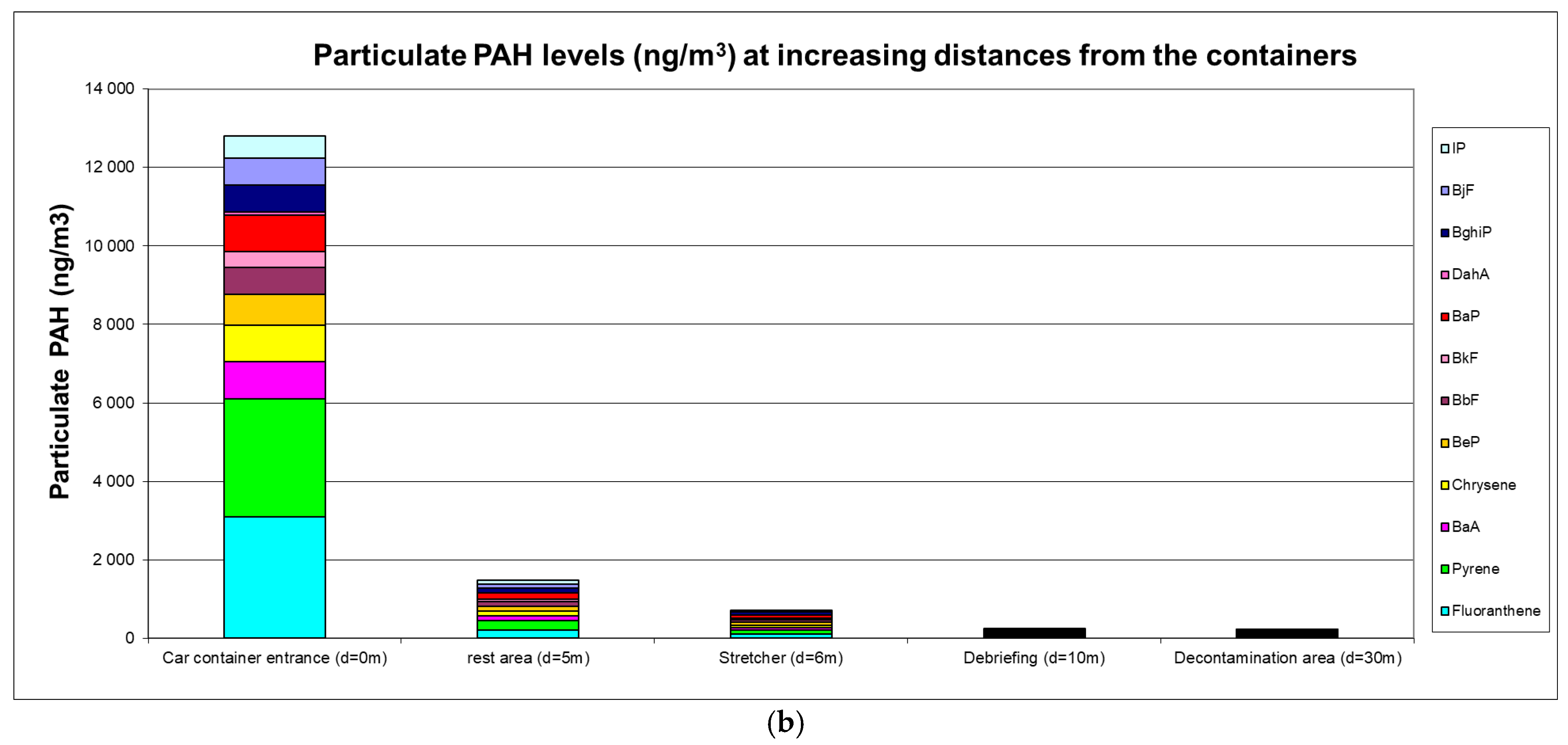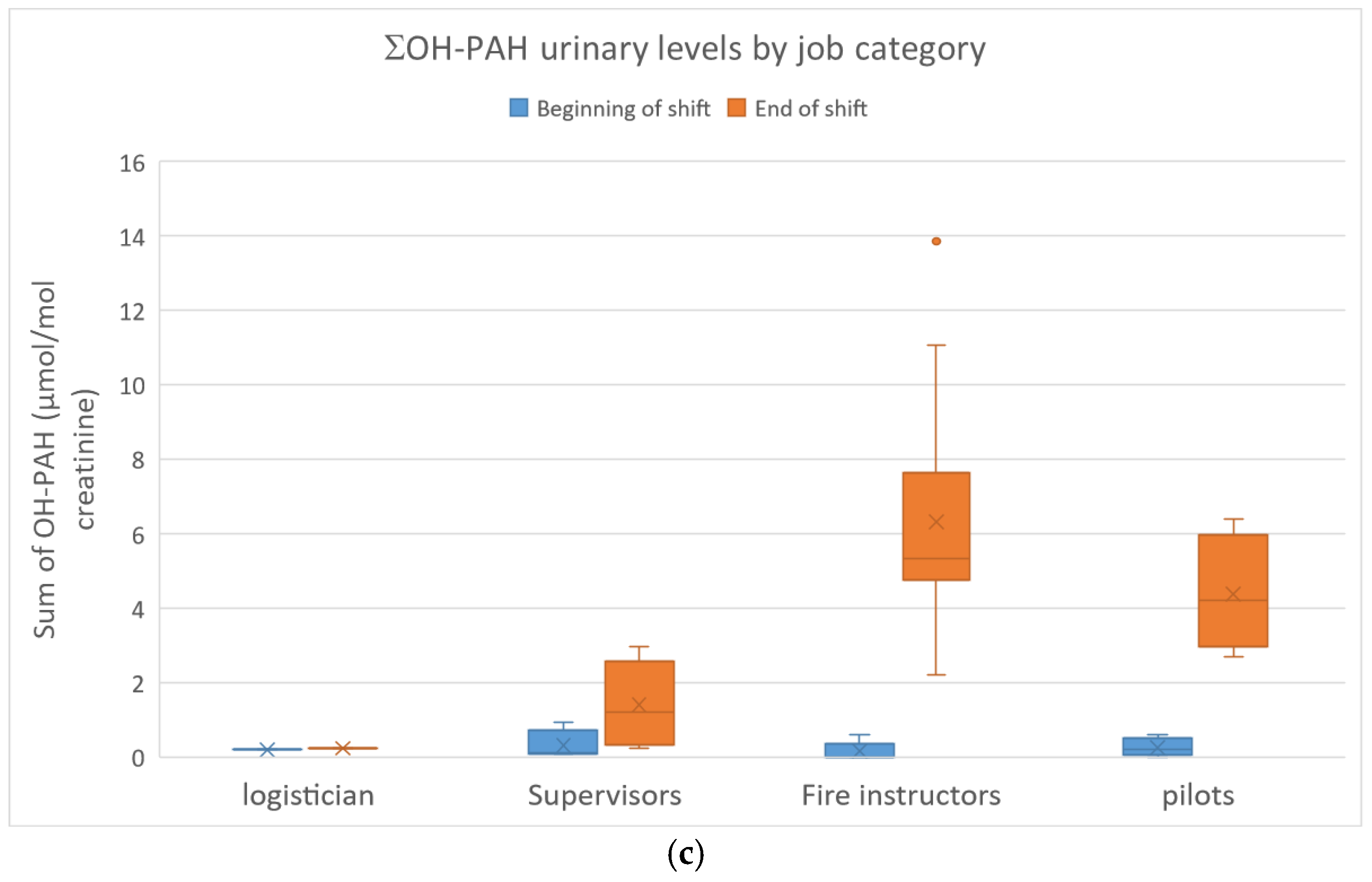Air, Skin, and Biological Monitoring of French Fire Instructors’ Exposure to Particles/PAHs During Controlled Fire and Mitigation Strategies
Abstract
1. Introduction
2. Materials and Methods
2.1. Population Characteristics
2.2. Air Monitoring Protocols
2.3. Skin Wipe Sampling
2.4. Biomonitoring Protocols
2.5. Statistics
3. Results
3.1. PM and Airborne PAH Levels
3.2. Skin Wipes
3.3. Biomonitoring Results
4. Discussion
- -
- Shower as soon as possible in order to remove any residual skin contamination.
- -
- Wash hands before eating to help reduce hand-to-mouth ingestion of chemical or biological contaminants.
- -
- Use untreated pallets and straw only, but no OSB (Oriented Strand Board), which has been associated with higher emissions [14]; ideally use simulated smoke generation wherever possible.
- -
- Use particle filter masks after removing SCBA in order to avoid inhaling particles/combustion products from contaminated protective gear after training.
- -
- Wear disposable (nitrile) gloves during removal of protective equipment, and use nitrile undergloves only.
- -
- Field decontamination using dish soap, water, and scrubbing in order to reduce PAH contamination on turnout jackets (−85% in Fent et al. study [25]) and cleansing wipes recommended to reduce PAH contamination on neck skin (−54%).
- -
- Encourage laundering and wet soap preliminary exposure reduction methods (post-fire) that are effective to reduce surface contamination and appear to prevent accumulation of contamination after repeated exposure [34].
- -
- Remove SCBA (at the end of exercises) at a greater distance (>10 m) from the containers and also hold debriefings at a distance of >10 m.
- -
- Harmonise cleaning and decontamination procedures for all instructors, and promote strict skin hygiene to remove combustion products.
5. Conclusions
Author Contributions
Funding
Institutional Review Board Statement
Informed Consent Statement
Data Availability Statement
Acknowledgments
Conflicts of Interest
References
- IARC (International Agency Research on Cancer). Occupational Exposure as a Firefighter; IARC: Lyon, France, 2022; Volume 132. [Google Scholar]
- Wah, W.; Gelaw, A.; Glass, D.C.; Sim, M.R.; Hoy, R.F.; Berecki-Gisolf, J.; Walker-Bone, K. Systematic review of impacts of occupational exposure to wildfire smoke on respiratory function, symptoms, measures and diseases. Int. J. Hyg. Environ. Health 2025, 263, 114463. [Google Scholar] [CrossRef] [PubMed]
- Demers, P.A.; DeMarini, D.M.; Fent, K.W.; Glass, D.C.; Hansen, J.; Adetona, O.; Andersen, M.H.G.; Beane Freeman, L.E.; Caban-Martinez, A.J.; Daniels, R.D.; et al. Carcinogenicity of occupational exposure as a firefighter. Lancet Oncol. 2022, 23, 985–986. [Google Scholar] [CrossRef] [PubMed]
- West, M.; Brown, S.; Noth, E.; Domitrovich, J.; Navarro DuBose, K. A review of occupational exposures to carcinogens among wildland firefighters. J. Occup. Environ. Hyg. 2024, 21, 741–764. [Google Scholar] [CrossRef] [PubMed]
- Barboni, T.; Cannac, M.; Pasqualini, V.; Simeoni, A.; Leoni, E.; Ciaramonti, N. Volatile and semi-volatile organic compounds in smoke exposure of firefighters during prescribed burning in the Mediterranean region. Int. J. Wildland Fire 2010, 19, 606–612. [Google Scholar] [CrossRef]
- Romagnoli, E.; Barboni, P.; Santoni, A.; Chiaramonti, N. Quantification of volatile organic compounds in smoke form prescribed burning and comparison with occupational exposure limits. Nat. Hazards Earth Syst. Sci. 2014, 14, 1049–1057. [Google Scholar] [CrossRef]
- Allonneau, A.; Mercier, S.; Menguy-Fleuriot, A.; Luu, S.C.; Louyot, C.; Nicolas, A.; Jost, D.; Jacques, N.; Bignand, M. Etude de l’exposition aux fumées d’incendie des sapeurs-pompiers affectés en structure de feu contrôlé. Arch. Mal. Prof. Environ. 2019, 80, 257–272. [Google Scholar] [CrossRef]
- Teixeira, J.; Sousa, G.; Azevedo, R.; Almeida, A.; Delerue-Matos, C.; Wang, X.; Santos-Silva, A.; Rodrigues, F.; Oliveira, M. Characterization of Wildland Firefighters’ Exposure to Coarse, Fine, and Ultrafine Particles; Polycyclic Aromatic Hydrocarbons; and Metal(loid)s, and Estimation of Associated Health Risks. Toxics 2024, 12, 422. [Google Scholar] [CrossRef] [PubMed] [PubMed Central]
- Papas, W.; Aranda-Rodriguez, R.; Fan, X.; Kubwabo, C.; Lee, J.S.L.; Fantin, E.; Zheng, E.D.; Keir, J.L.A.; Matschke, D.; Blais, J.M.; et al. Occupational Exposure of On-Shift Ottawa Firefighters to Flame Retardants and Polycyclic Aromatic Hydrocarbons. Toxics 2024, 12, 677. [Google Scholar] [CrossRef] [PubMed] [PubMed Central]
- Kirk, K.M.; Logan, M.B. Firefighting instructors’ exposures to polycyclic aromatic hydrocarbons during live fire training scenarios. J. Occup. Environ. Hyg. 2015, 12, 227–234. [Google Scholar] [CrossRef] [PubMed]
- Probert, C.; Ormond, R.B.; Baynes, R.E. Impact of Skin Decontamination Wipe Solutions on the Percutaneous Absorption of Polycyclic Aromatic Hydrocarbons. Toxics 2024, 12, 716. [Google Scholar] [CrossRef] [PubMed] [PubMed Central]
- Cherry, N.; Aklilu, Y.A.; Beach, J.; Britz-McKibbin, P.; Elbourne, R.; Galarneau, J.M.; Gill, B.; Kinniburgh, D.; Zhang, X. Urinary 1-hydroxypyrene and Skin Contamination in Firefighters Deployed to the Fort McMurray Fire. Ann. Work Expo. Health 2019, 63, 448–458. [Google Scholar] [CrossRef] [PubMed] [PubMed Central]
- Rossbach, B.; Wollschläger, D.; Letzel, S.; Gottschalk, W.; Muttray, A. Internal exposure of firefighting instructors to polycyclic aromatic hydrocarbons (PAH) during live fire training. Toxicol. Lett. 2020, 331, 102–111. [Google Scholar] [CrossRef] [PubMed]
- Fent, K.W.; Toennis, C.; Sammons, D.; Robertson, S.; Bertke, S.; Calafat, A.M.; Pleil, J.D.; Geer Wallace, M.A.; Kerber, S.; Smith, D.L.; et al. Firefighters’ and instructors’ absorption of PAHs and benzene during training exercises. Int. J. Hyg. Environ. Health 2019, 222, 991–1000. [Google Scholar] [CrossRef] [PubMed]
- Lang, F.; Wollschläger, D.; Letzel, D.S.; Roßbach, B. Renal excretion of 1,2-dihydroxynaphthalene (DHN) in firefighting instructors after exposure to polycyclic aromatic hydrocarbons (PAHs) during live fire training. Sci. Rep. 2024, 14, 15230. [Google Scholar] [CrossRef] [PubMed] [PubMed Central]
- Germin-Aizac, J.; Maitre, A.; Balducci, F.; Montlevier, S.; Marques, M.; Tribouiller, J.; Demeilliers, C.; Persoons, R. Bitumen fumes and PAHs in asphalt road paving: Emission characteristics, determinants of exposure and environmental impact. Environ. Res. 2023, 228, 115824. [Google Scholar] [CrossRef] [PubMed]
- INRS. Metropol HAP M-448 2024. Available online: https://www.inrs.fr/publications/bdd/metropol/fiche.html?refINRS=METROPOL_448 (accessed on 18 December 2024).
- Barbeau, D.; Maître, A.; Marques, M. Highly sensitive routine method for urinary 3-hydroxybenzo[a]pyrene quantitation using liquid chromatography-fluorescence detection and automated off-line solid phase extraction. Analyst 2011, 136, 1183–1191. [Google Scholar] [CrossRef] [PubMed]
- Barbeau, D.; Lutier, S.; Marques, M.; Persoons, R.; Maitre, A. Comparison of gaseous polycyclic aromatic hydrocarbon metabolites according to their specificity as biomarkers of occupational exposure: Selection of 2-hydroxyfluorene and 2-hydroxyphenanthrene. J. Hazard. Mater. 2017, 332, 185–194. [Google Scholar] [CrossRef]
- Blomqvist, P.; McNamee, M.; Stec, A.A.; Gylestam, D.; Karlsson, D. Characterisation of Fire Generated Particles; SP Technical Research Institute of Sweden: Stockholm, Sweden, 2010. [Google Scholar]
- Navarro, K.M.; Cisneros, R.; Noth, E.M.; Balmes, J.R.; Hammond, S.K. Occupational exposure to polycyclic aromatic hydrocarbon of wildland firefighters at prescribed and wildland fires. Environ. Sci. Technol. 2017, 51, 6461–6469. [Google Scholar] [CrossRef]
- Fernando, S.; Shaw, L.; Shaw, D.; Gallea, M.; VandenEnden, L.; House, R.; Verma, D.K.; Britz-McKibbin, P.; McCarry, B.E. Evaluation of Firefighter Exposure to Wood Smoke during Training Exercises at Burn Houses. Environ. Sci. Technol. 2016, 50, 1536–1543. [Google Scholar] [CrossRef] [PubMed]
- Mayer, A.C.; Horn, G.P.; Fent, K.W.; Bertke, S.J.; Kerber, S.; Kesler, R.M.; Newman, H.; Smith, D.L. Impact of select PPE design elements and repeated laundering in firefighter protection from smoke exposure. J. Occup. Environ. Hyg. 2020, 17, 505–514. [Google Scholar] [CrossRef]
- Everaert, S.; Schoeters, G.; Claes, K.; Raquez, J.M.; Buffel, B.; Vanhaecke, T.; Moens, J.; Laitinen, J.; Van Larebeke, N.; Godderis, L. Balancing Acute and Chronic Occupational Risks: The Use of Nitrile Butadiene Rubber Undergloves by Firefighters to Reduce Exposure to Toxic Contaminants. Toxics 2023, 11, 534. [Google Scholar] [CrossRef] [PubMed]
- Fent, K.W.; Alexander, B.; Roberts, J.; Robertson, S.; Toennis, C.; Sammons, D.; Bertke, S.; Kerber, S.; Smith, D.; Horn, G. Contamination of firefighter personal protective equipment and skin and the effectiveness of decontamination procedures. J. Occup. Environ. Hyg. 2017, 14, 801–814. [Google Scholar] [CrossRef] [PubMed]
- Fent, K.W.; Eisenberg, J.; Snawder, J.; Sammons, D.; Pleil, J.D.; Stiegel, M.A.; Mueller, C.; Horn, G.P.; Dalton, J. Systemic exposure to PAHs and benzene in firefighters suppressing controlled structure fires. Ann. Occup. Hyg. 2014, 58, 830–845. [Google Scholar] [PubMed]
- CDC. Fourth National Report on Human Exposure to Environmental Chemicals: Updated Tables, January 2019, Volume Two. Available online: https://www.cdc.gov/exposurereport/data_tables.html (accessed on 12 December 2024).
- Barros, B.; Oliveira, M.; Morais, S. Biomonitoring of firefighting forces: A review on biomarkers of exposure to health—Relevant pollutants released from fires. J. Toxicol. Environ. Health B 2023, 26, 127–171. [Google Scholar] [CrossRef]
- Marquès, M.; Persoons, R. Comparison of urinary 3-hydroxybenzo(a)Pyrene (3-OHBaP) and trans-anti-7,8,9,10-tetrahydroxy-7,8,9,10-tetrahydrobenzo(a)Pyrene (TetraolBaP) as biomarkers of exposure to carcinogenic BaP. Int. J. Hyg. Environ. Health 2025, 263, 114476. [Google Scholar] [CrossRef]
- Sousa, G.; Teixeira, J.; Delerue-Matos, C.; Sarmento, B.; Morais, S.; Wang, X.; Rodrigues, F.; Oliveira, M. Exposure to PAHs during Firefighting Activities: A Review on Skin Levels, In Vitro/In Vivo Bioavailability, and Health Risks. Int. J. Environ. Res. Public Health 2022, 19, 12677. [Google Scholar] [CrossRef]
- Horn, G.P.; Madrzykowski, D.; Neumann, D.L.; Mayer, A.C.; Fent, K.W. Airborne contamination during post-fire investigations: Hot, warm and cold scenes. J. Occup. Environ. Hyg. 2022, 19, 35–49. [Google Scholar] [CrossRef]
- INRS. Base Biotox. 2024. Available online: https://www.inrs.fr/publications/bdd/biotox/dosage.html?refINRS=Dosage_151 (accessed on 18 December 2024).
- Hwang, J.; Xu, C.; Grunsted, P.; Agnew, R.J.; Malone, T.R.; Clifton, S.; Thompson, K.; Xu, X. Urinary Metabolites of Polycyclic Aromatic Hydrocarbons in Firefighters: A Systematic Review and Meta-Analysis. Int. J. Environ. Res. Public Health 2022, 19, 8475. [Google Scholar] [CrossRef]
- Wilkinson, A.F.; Fent, K.W.; Mayer, A.C.; Chen, I.C.; Kesler, R.M.; Kerber, S.; Smith, D.L.; Horn, G.P. Use of Preliminary Exposure Reduction Practices or Laundering to Mitigate Polycyclic Aromatic Hydrocarbon Contamination on Firefighter Personal Protective Equipment Ensembles. Int. J. Environ. Res. Public Health 2023, 20, 2108. [Google Scholar] [CrossRef]





| Main Characteristics | Study Population n (%) |
|---|---|
| Gender | |
| Female | 2 (9%) |
| Male | 20 (91%) |
| Smoking status | |
| Smokers | 3 (13.6%) |
| Non-smokers | 19 (86.4%) |
| Age | |
| <35 years | 5 (23%) |
| 35–40 years | 9 (41%) |
| >40 years | 8 (36%) |
| Seniority as FF | |
| ≤5 years | 12 (55%) |
| >5 years | 10 (45%) |
| Job categories | |
| Fire Instructors (FI) | 13 (59%) |
| Pilots (P) | 4 (18%) |
| Supervisors (SU) | 4 (18%) |
| Logisticians (L) | 1 (05%) |
| Undergloves | |
| Latex | 4 (18%) |
| Vinyl | 5 (18%) |
| Nitrile | 6 (32%) |
| No undergloves | 6 (32%) |
| Respiratory Protective Equipment (RPE) | |
| Fire Instructors (FI) | 100% SCBA inside containers |
| Pilots (P) | 100% SCBA or FFP3* half-mask inside containers |
| Supervisors (SU) | 26% FFP3* half-mask/74% none |
| Logisticians (L) | None |
Disclaimer/Publisher’s Note: The statements, opinions and data contained in all publications are solely those of the individual author(s) and contributor(s) and not of MDPI and/or the editor(s). MDPI and/or the editor(s) disclaim responsibility for any injury to people or property resulting from any ideas, methods, instructions or products referred to in the content. |
© 2025 by the authors. Licensee MDPI, Basel, Switzerland. This article is an open access article distributed under the terms and conditions of the Creative Commons Attribution (CC BY) license (https://creativecommons.org/licenses/by/4.0/).
Share and Cite
Zangl, P.; Collart, C.; Persoons, R. Air, Skin, and Biological Monitoring of French Fire Instructors’ Exposure to Particles/PAHs During Controlled Fire and Mitigation Strategies. Toxics 2025, 13, 106. https://doi.org/10.3390/toxics13020106
Zangl P, Collart C, Persoons R. Air, Skin, and Biological Monitoring of French Fire Instructors’ Exposure to Particles/PAHs During Controlled Fire and Mitigation Strategies. Toxics. 2025; 13(2):106. https://doi.org/10.3390/toxics13020106
Chicago/Turabian StyleZangl, Pauline, Clément Collart, and Renaud Persoons. 2025. "Air, Skin, and Biological Monitoring of French Fire Instructors’ Exposure to Particles/PAHs During Controlled Fire and Mitigation Strategies" Toxics 13, no. 2: 106. https://doi.org/10.3390/toxics13020106
APA StyleZangl, P., Collart, C., & Persoons, R. (2025). Air, Skin, and Biological Monitoring of French Fire Instructors’ Exposure to Particles/PAHs During Controlled Fire and Mitigation Strategies. Toxics, 13(2), 106. https://doi.org/10.3390/toxics13020106








